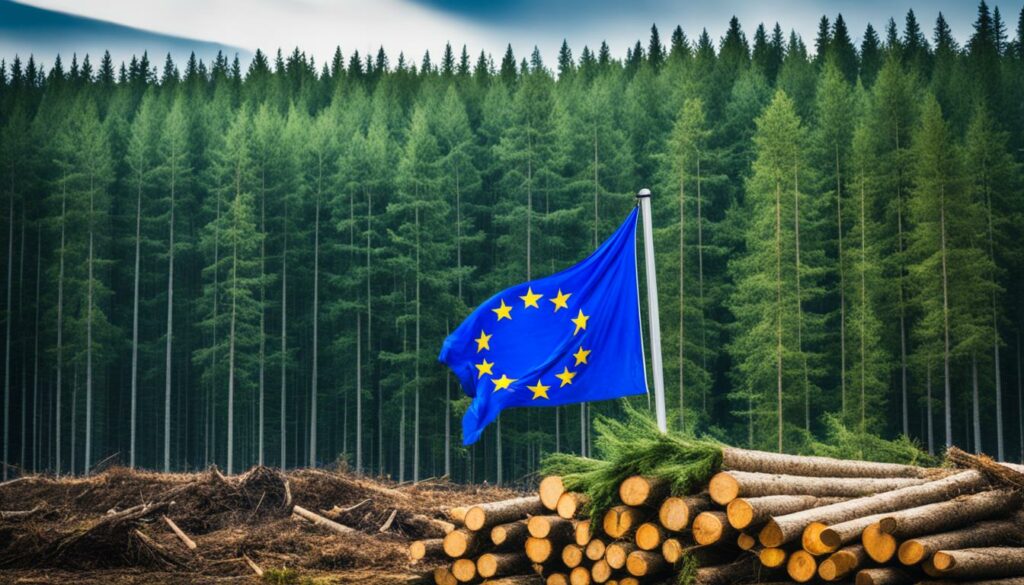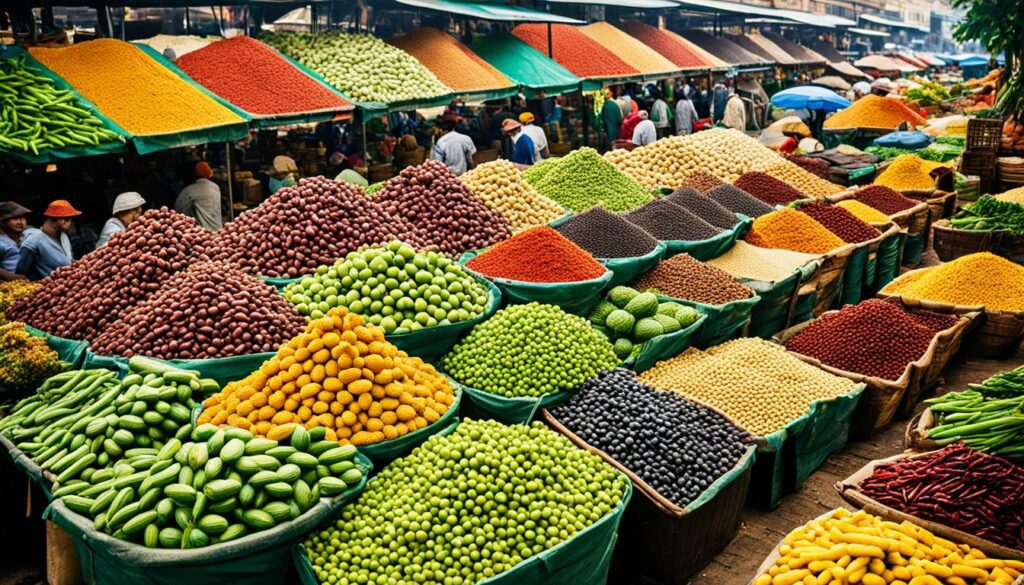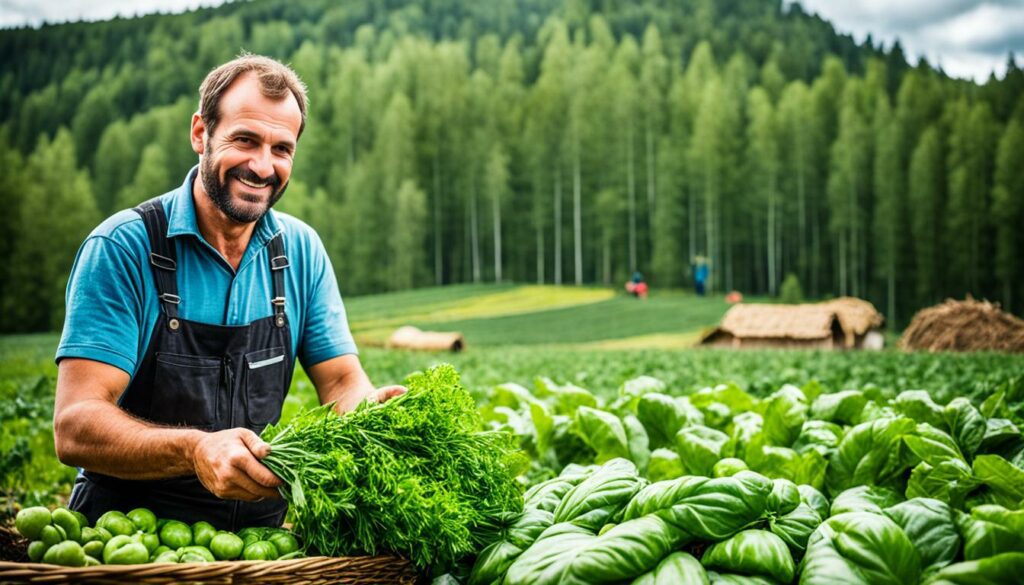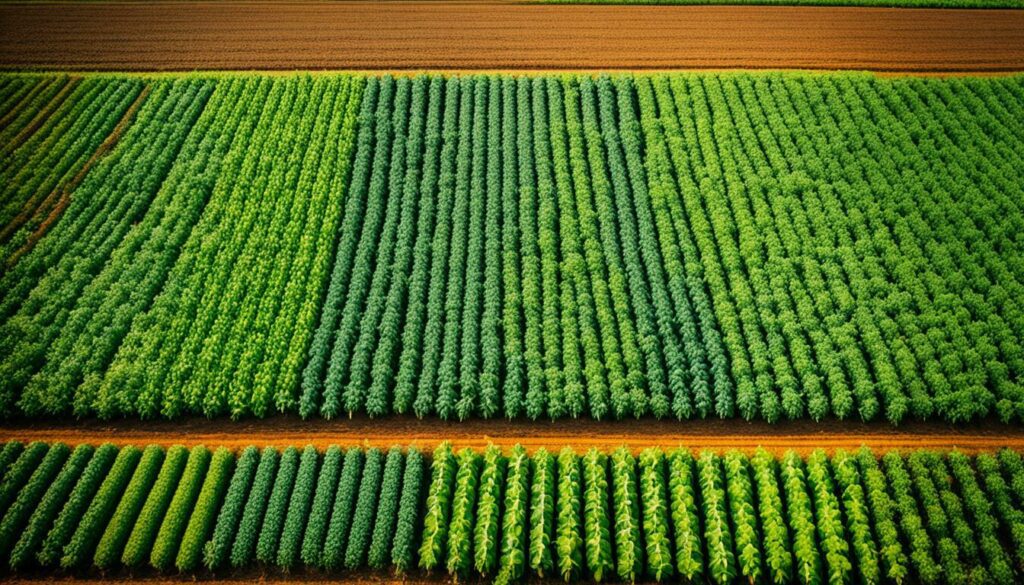Menu

Did you know that 80% of the world’s forests are cut down due to farming? This figure tells us we need strong laws to protect the environment. The EU has started this through the EU Deforestation Regulation (EUDR) under the EU Green Deal.
The EUDR starts in December 2024. It focuses on products like soy, beef, palm oil, wood, cocoa, coffee, and rubber. These goods cause about 13-16% of deforestation from EU imports. Annually, they destroy 203,000 hectares of forest and add 116 million tonnes of CO₂.
The EU wants to work with countries that produce these items. It aims to ensure they use land wisely and make supply chains clear. The law covers activities damaging forests after 31 December 2020. It does more than what local laws in producer countries require. This shows the EU’s strong dedication to protect nature.
The EU Deforestation Regulation (EUDR) marks a big step in the EU’s fight against worldwide deforestation. It went into action on 29 June 2023. It covers a wide list of goods, such as cattle, cocoa, and coffee.
The EU Deforestation Regulation focuses hard on due diligence. Now, companies must check their supply chains to make sure they don’t use deforestation. This means they have to know and follow policies that protect the environment.
Companies and traders get 18 months to meet these new rules. This bit of time helps small businesses adjust. It makes sure more companies can keep up with the tough new standards.
The law looks at more than just stopping deforestation. It also checks products like leather and chocolate. This shows the EU wants to deal with all parts of harm to nature.
The EU put €70 million aside to help partner countries go greener and stop illegal cutting down trees. This move shows the EU is serious about working with others to end deforestation.
In 2021, the EU did a Fitness Check on its law about using timber. This check looked at how well the laws worked. It found places to improve, making the laws stronger.
The big aim of the EU Deforestation Regulation is to cut down a lot on carbon emissions. We’re talking about 32 million tonnes less a year. It’s a goal that everyone in the EU, partner countries, and businesses work towards. They want to ensure that the use of land and where timber is sourced meet the EUDR’s high standards.
The importance of global agriculture and its impact on deforestation is critical. The European Union (EU) has taken a big step with Regulation (EU) 2023/1115. This regulation started on 29 June 2023 aims to reduce the EU’s deforestation effect. It does so by setting strong laws that directly influence products like palm oil, cattle, and cocoa.

Agriculture is the main reason behind global deforestation. Between 1990 and 2020, about 420 million hectares of forest vanished because of farming. This led to roughly 23% of greenhouse gas emissions. The EU’s rule targets a decrease in these emissions by at least 32 million metric tonnes yearly.
This effort shows how crucial it is to change agriculture practices. We need these changes to meet sustainable development goals.
The EU is a leader in global environmental protection. It has put strict rules in place for companies that sell products in the EU. These companies must prove their goods are free from deforestation and meet human rights standards by the end of 2024.
Smaller businesses have more time to meet these standards. This shows the EU wants to help companies without compromising its goals.
The EU aims to cooperate with other countries. Together, they work towards a world without deforestation. This shows the EU’s strong commitment to international environmental laws and actions.
The new Regulation for deforestation-free goods started on 29 June 2023. It’s a big step for keeping forests safe. By cutting down on harmful products, the EU hopes to lower its carbon footprint by 32 million tonnes each year.
These actions show the EU is serious about farming and protecting forests. They want to stop deforestation and harmful practices.
Under the EUDR, all items and their parts must come from places that don’t cut down forests. This includes things like cattle, cocoa, coffee, oil palm, rubber, soya, and wood. The EU’s goal is to fight deforestation caused by farming and protect forests. It makes sure goods meet strict environmental and social rules.
Companies must obey these rules or face big fines and other punishments. They could get fined up to 4% of their EU sales, have their goods taken away, or lose access to public money.
Companies have to be very careful in their checks to make sure their goods don’t harm forests. They must look into every part of their supply chain. And they need to take steps to stop bad products from being sold.
It’s a must for companies to say they’ve done these checks. They need to show that their products are okay and follow all the laws. Each country in the EU will also check on companies to make sure they’re doing the right things.
The checks companies do include looking at every step of the supply chain. They ensure that everyone involved follows the laws that protect the environment and people. The point is to save forests and encourage good farming all around the world.
The EU Deforestation Regulation (EUDR) changes the way supply chains work. It makes sure goods like cattle, cocoa, coffee, palm oil, rubber, soy, and timber do not come from deforestation. This rule asks companies to show where these goods come from. It aims to make sure farms and suppliers follow sustainable practices.

Having zero deforestation is key under the EUDR. Source Intelligence has a tool that uses satellites and automation to help. It checks that products meet the right standards. But, finding out where goods come from is still hard. This is because they go through many hands before reaching a store.
Small and medium-sized businesses (SMEs) find it especially tough to meet the EUDR rules. They often don’t have the tech or money to track their products so carefully. There are new tools to help them, but challenges remain. SMEs are advised to use recognised standards and invest in easy-to-use software.
The EUDR brings many changes to how things are done:
| Commodity | 2022 Import Value (€ billions) | Top Source Countries |
|---|---|---|
| Wood Products | 50.7 | Mainland China, UK, Brazil |
| Pulp and Paper | 4.6 | Mainland China |
| Coffee | Not Data Provided | Various Emerging Markets |
The EUDR wants to encourage better forestry practices and traceable goods. But, SMEs find it hard to meet these rules. Technology and support for smaller businesses are key. They help ensure everyone in the supply chain acts sustainably.
The European Union is making big changes with a new land use policies rule. This rule is aimed at cutting down 32 million tonnes of carbon emissions yearly. It looks closely at how we use sustainable forestry practices and farm the land. The old EU Timber Rule is gone, replaced with this new one. Companies, big and small, have 18 months to follow the new rules.
A lot of forests get turned into farmland because of agriculture. Since agriculture is the top reason for forests becoming farms, it’s now under a strict rule. This rule says that making goods like soy, beef, and palm oil cannot harm the environment. It aims to bring back a healthy balance to our ecosystems.
If we want less deforestation, we need farming practices that do not harm the land. To do this, we must change how we farm. The goal is to switch to methods that are not just good for the planet but also for the people working the land. This change to better farming, however, faces many challenges. Producers often lack support and face money problems when trying to be more sustainable. Overcoming these issues needs everyone’s help and investment in new farming technologies.
The EU has a plan that brings everyone together to tackle deforestation right where it starts. They are helping countries like Brazil and Indonesia find ways to farm that are green and also profitable. But, continuing to keep investors interested in this green approach is very important.
| Commodity | Expected Changes | Sustainable Practices | Challenges |
|---|---|---|---|
| Soy | Deforestation-Free Certification | Crop rotation, Biotechnology | Traceability, Compliance Costs |
| Beef | Land Management Reforms | Rotational Grazing, Silvopasture | Technological Adoption, Investor Confidence |
| Palm Oil | Sustainable Plantation Management | Agroforestry, Reduced Impact Logging | Economic Feasibility, Institutional Barriers |
The EU Deforestation Regulation (EUDR) includes Article 30. This article highlights the need to work together with producer countries. Its goal is to tackle deforestation causes and improve the EUDR’s rules. By focusing on working together, it helps reduce risks and pushes for sustainable farming globally.

Article 30 helps the EU interact with countries making products like soy, beef, and palm oil. The main aim is to encourage the good use of land and improve tracking. This way, the EU can assist these producer nations to farm more sustainably. Their goods will then meet the tough deforestation rules.
Using Article 30 can benefit countries making these products in several ways. Firstly, it helps make sure goods are deforestation-free by tracking them better. This meets the EU’s rules. Also, it can improve how land is used, which is good for the environment and farming. Plus, it supports better farming methods through help with money and knowledge. This is a win for both the EU and the producer countries.
Moreover, the numbers show why this is so important. Farming causes 80% of the world’s forest loss. The EU buying these goods adds to that, clearing about 203,000 hectares of forests yearly. So, making Article 30 work well is key to reaching sustainable goals.
The EU Deforestation Regulation (EUDR) has led companies to use high-tech solutions. These solutions help firms be compliant easily. They use new tools like traceability platforms and remote sensing.
To follow the EUDR, companies rely on new traceability platforms. They track where products come from and if they’re deforestation-free. For example, Dimitra checks if crops were sourced without deforestation using blockchain. It helps millions of small farmers. By tracking products closely, companies meet EUDR rules.
Remote sensing tech gives important data for watching deforestation. It shows what’s happening on the ground live. This helps in better environmental care. Tools like satellite images and drones are key for keeping an eye on deforestation.
Using these tech solutions means companies do more than just meet the EUDR. They also help reduce deforestation worldwide. Plus, it shows these businesses care about sustainable use of land. This connects with the EUDR’s bigger aims.
| Technology | Function | Impact |
|---|---|---|
| Blockchain Platforms | Verify deforestation-free sourcing | Supports 600 million smallholder farmers |
| Remote Sensing | Real-time land monitoring | Accurate deforestation data |
| Cloud-Based Compliance Solutions | Risk assessments, supplier onboarding | Ensures EUDR compliance |
Sustainable forestry practices help keep our planet healthy in the long run. By using these methods, we save different plants and animals. We also fight climate change by cutting down on the greenhouse gases from cutting down trees. This problem makes up more than 10% of the damage to our climate.

Sustainable forestry has many good points beyond helping our environment. It leads to:
The European Commission has put a lot of money into its project for clean farming. It got 70 million euros, mostly from Germany, the Netherlands, and France. This shows how important it is to support efforts like keeping our forests healthy.
Many important countries are leading the way in green forestry:
In 2024, the SAFE Project will start in Vietnam and the Democratic Republic of the Congo. This shows how the whole world is getting behind saving forests. The EU makes sure everyone follows its rules to help nature.
Here are some examples of how different countries are working for green forests:
| Country | Key Initiative | Impact | Brazil | SAFE Project | Enhanced land use, reduced deforestation |
|---|---|---|
| Indonesia | Sustainable timber sourcing | Maintained forest cover, mitigated emissions |
| Ecuador | Forest conservation initiatives | Boosted biodiversity, local economy |
| Zambia | SAFE Project | Sustainable agriculture, reduced deforestation |
The EUDR faces many obstacles, from problems in producer countries to economic and tech issues. Let’s explore these difficulties.
Producer nations have big hurdles, like weak laws and no common plans. EU sorts countries by risk, putting them as high, medium, or low. Wrongly high-risk naming makes all industries seem risky. This impacts over 600,000 small farm families. They need help to farm sustainably.
There are big costs to meet EUDR standards. Many small farmers can’t pay. This affects the trust investors have and the economy’s health.
Trying to be more digital links farms to government databases for better records. But not all areas can go digital. Plus, there’s not enough help from the EU and local governments. Still, making better trade reports is key to prove where products come from and their legality.
| Challenge | Description | Impact |
|---|---|---|
| Institutional Barriers | Fragmented governance and inadequate enforcement of local laws | Delays and misclassification in risk assessment |
| Economic Challenges | High financial investments needed for sustainable practices | Market exclusion and low investor confidence |
| Technological Challenges | Lack of infrastructure for digitisation and supply chain transparency | Inefficient reporting and tracking systems |
Fighting these hurdles is key to making the EUDR work. It will improve timber trade safety and help local farmers.
The EU Deforestation Regulation (EUDR) started on 29 June 2023. It aims to change global trade and markets in a big way. This new rule makes sure that products coming into the EU don’t add to deforestation. With 18 months to follow the law, we’re seeing big changes in what’s being traded.

The EUDR will change what the world buys and sells. Items like soy, beef, and palm oil now must meet tough eco-friendly rules. This pushes sellers to use methods that don’t harm nature. It’s not just about following rules. It’s also about reshaping how goods are made, making the process clear and responsible.
Working together, the EU and its partners aim to make trade greener. This creates new chances for businesses that act quickly and move towards more sustainable ways. They could get special access to the EU’s big market. This shows that trading without hurting the planet has big benefits.
The EU is serious about fighting climate change. Laws like the EUDR are part of this, aiming to cut 32 million tonnes of carbon every year. This effort changes how things are traded worldwide, not just in the EU.
The Regulation on deforestation-free products started on June 29, 2023. It’s a big move globally for the environment. This key rule will greatly lower deforestation and help fight climate change. It shows the EU’s strong stand for saving natural areas.
From 1990 to 2020, over 420 million hectares of forest were deforested. That’s more space than the European Union. This new law aims to shrink these high losses.
Making businesses and traders stick to strict rules will help. They must prove their products are not linked to deforestation. This means almost all goods will be checked before reaching Europe. The EU’s hard work in this area will lead to less deforestation, keeping harmful goods out of its market.
The rule also tackles a big part of climate change. The FAO tells us that deforestation causes about 11% of all greenhouse gases. This law targets to lower these emissions by 32 million tonnes each year.
By making everyone produce and buy more fairly, the EU is making a real difference. This pushes for a healthier Earth and brighter future for all. It aims for practices that are kind to our planet.
Companies will have 18 months to fit the new regulations. Small firms get a bit more time. This fair time plan encourages all to help the Earth. The benefits of these changes will not only be for Europe. They will touch the whole planet, making the environment better for us all.
The EU is leading by example with these rules. It’s a vital step towards a world that cares for its land and forests. This effort is key in the global fight against climate change.
The EU Deforestation Regulation might change how trade works. This could lead to products being sold elsewhere and problems for those who make things on a small scale.

The EU Deforestation Regulation might push deforested products out of the EU and into other markets. To stop this, we need rules that everyone follows. These rules must be clear and strong so that products made by cutting down forests can’t dodge them by selling somewhere else. The goal is to cut 32 million metric tonnes of carbon emissions a year, making it important to watch over the rules closely.
Smallholders find it hard to follow the tough rules of the EU Deforestation Regulation. Because they are small, they might not have the money or knowledge to do what’s needed.
This means they need help that focuses on their needs. For example, the Regulation gives small businesses more time, 18 months, to get used to the new rules. They also need money, training, and technology to help them keep up. This way, we can make sure they’re not left out of important markets.
The 2021 Fitness Check looked at how well past rules fought against cutting down trees illegally. By using what we learned from that check, we can make it easier for everyone involved to adjust to the new regulations.
The EU Deforestation Regulation (EUDR) aims to cut down on carbon emissions and deforestation. These goals are vital for lessening the harmful effects of products traded in the EU.
The EUDR wants to reduce carbon emissions by 32 million metric tonnes every year. It plays a crucial part in worldwide efforts against climate change. Its goals include supporting sustainable farming and making sure EU uses do not harm forests. This push aims to make supply chains clearer and more responsible.
Adapting policies is crucial for EUDR’s success. It needs to tackle new challenges and grab chances to get better. The EUDR will work closely with other countries to encourage responsible farming.
This act of changing with the times is key for dealing with new tech and changes in the economy. It ensures the EUDR keeps working towards a cleaner environment. This keeps the balance between growing our economy and protecting the planet for the future.
Agricultural production is behind 80% of global forest loss. To tackle this, we’re looking at alternative agricultural practices under the EU framework. These new methods aim to keep our food coming without harming more forests.

Using land better is key. It means making the most of land we have without needing to cut down more forests. There’s a lot of land in major farming areas that could be used better. The EU’s need for imports leads to 13-16% of deforestation globally.
This clears more than 203,000 hectares of forests yearly. But, using smarter methods like precision agriculture and crop rotation could cut this down. Yet, not many are ready to invest in these new farming approaches.
Another smart move is to use lands that are damaged but can be recovered. There are large areas ready for farming again. This way, we can stop turning healthy ecosystems into farmlands. The EU has even pledged €70 million for this cause.
By working with producer countries, Article 30 of the EUDR supports the better use of such lands. Also, new ways to track products like beef and soy are key. They make sure what we buy comes from places that protect the environment.
So, making better use of existing lands and fixing degraded ones are both good options. They offer a path to farming without cutting down more trees, meeting both food and environmental needs.
The EU Deforestation Regulation (EUDR) marks a big step for green laws. It pledges to lower carbon emissions. The goal is to slash at least 32 million metric tonnes yearly from what the EU uses and makes. This rule is part of the EU Green Deal, which wants to boost sustainable farming and lessen harm from products like cattle and palm oil.
Thanks to Regulation (EU) 2023/1115, businesses get time to follow the new rules. Large companies and traders have 18 months to catch up. Smaller firms have a bit longer, 24 months. Companies must prove their products are free of deforestation and follow the law. Not doing this could lead to big fines, up to 4% of their turnover across the EU.
The EUDR deals with deforestation from farming and asks countries to match up on laws, like the UTP-Directive. This shows the need for careful balance in legal issues. Getting these new rules right means focusing on new ways and green practices. It will change how goods move around the world. The EU is leading the way towards better environmental care with the EUDR. This rule is more than a set of rules. It’s a plan for greener, better policies. It shows the EU’s strong commitment to the planet and to a healthy future.
The EUDR is a big part of the EU Green Deal. It stops items like soy, beef, and palm oil from getting into Europe. This is to make sure no more forests are cut down to make these products.
Many things like cattle, cocoa, and coffee fall under it. Also, oil palm, rubber, and wood are included. They must be made in a way that doesn’t harm forests from 2021 onwards.
80% of forest loss is because of farming. The EUDR sets tough rules to change this. It pushes for farming that’s kind to the earth.
The EUDR says products must not come from cut-down forests. Businesses must check and fix any harmful practices. They also have to show they are following local rules about the environment and people.
Products must be traced all the way to where they were made. This is to make sure they didn’t come from harmed forests.
SMEs find it hard because they lack tech and money. They struggle to follow the EUDR’s tough rules.
The EUDR pushes for better land use and farming. It wants to stop cutting forests but keep food and wood growing.
Article 30 is about working with countries that grow these products. It aims to solve the reasons for forest loss.
New tech helps to watch over farms and forests. It makes it easier for countries to follow the EUDR.
The EUDR will cut down on forest loss. This helps fight climate change. It makes sure products in Europe are made the right way.
There might be more products from cut-down forests in other places. And some small farmers might be left out. To fix this, we must work with these countries and help small farmers use better ways.
The EUDR looks to make big changes over time. It wants to protect forests and farm in a way that’s safe for the earth. Staying flexible and making smart choices will help it succeed.
The EUDR asks for smarter use of land and not using new areas. It aims to make enough without hurting more forests.